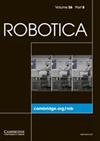织物折叠:无需专家示范即可学习高效织物折叠
IF 2.7
4区 计算机科学
Q3 ROBOTICS
引用次数: 0
摘要
由于在织物处理过程中存在复杂的动力学和潜在的自闭性,自主织物操作是一项具有挑战性的任务。织物折叠操作的直观方法首先是在折叠过程开始前获得平滑和展开的织物配置。然而,事实证明,将取放等准静态动作和甩动等动态动作结合起来,不足以有效地展开袖子大多塞在衣服里面的长袖 T 恤。为了解决这一局限性,本文引入了一种增强型准静态动作,即 "拾放拖",专门用于处理这种类型的织物配置。此外,本文还设计了一种高效的双臂操纵系统,该系统结合了准静态动作(包括取放和拾取拖拽)和动态甩动动作,可灵活地将织物操纵成展开和平滑的配置。随后,在确认织物已充分展开并检测到所有织物关键点后,就会采用基于关键点的启发式折叠算法进行织物折叠处理。为了解决真实织物公开关键点检测数据集稀缺的问题,我们收集了真实场景中各种织物配置和类型的图像,创建了一个全面的织物折叠关键点数据集。该数据集旨在提高关键点检测的成功率。此外,我们还评估了我们提出的系统在真实世界环境中的有效性,该系统可以稳定可靠地展开和折叠各种类型的织物,包括具有挑战性的情况,例如长袖 T 恤衫的大部分袖子都塞进了衣服里面。具体来说,我们的方法在长袖 T 恤衫的折叠方面达到了 0.822 的覆盖率和 0.88 的成功率。补充材料和数据集可在我们的项目网页 https://sites.google.com/view/fabricfolding 上查阅。本文章由计算机程序翻译,如有差异,请以英文原文为准。
FabricFolding: learning efficient fabric folding without expert demonstrations
Autonomous fabric manipulation is a challenging task due to complex dynamics and potential self-occlusion during fabric handling. An intuitive method of fabric-folding manipulation first involves obtaining a smooth and unfolded fabric configuration before the folding process begins. However, the combination of quasi-static actions like pick & place and dynamic action like fling proves inadequate in effectively unfolding long-sleeved T-shirts with sleeves mostly tucked inside the garment. To address this limitation, this paper introduces an enhanced quasi-static action called pick & drag, specifically designed to handle this type of fabric configuration. Additionally, an efficient dual-arm manipulation system is designed in this paper, which combines quasi-static (including pick & place and pick & drag) and dynamic fling actions to flexibly manipulate fabrics into unfolded and smooth configurations. Subsequently, once it is confirmed that the fabric is sufficiently unfolded and all fabric keypoints are detected, the keypoint-based heuristic folding algorithm is employed for the fabric-folding process. To address the scarcity of publicly available keypoint detection datasets for real fabric, we gathered images of various fabric configurations and types in real scenes to create a comprehensive keypoint dataset for fabric folding. This dataset aims to enhance the success rate of keypoint detection. Moreover, we evaluate the effectiveness of our proposed system in real-world settings, where it consistently and reliably unfolds and folds various types of fabrics, including challenging situations such as long-sleeved T-shirts with most parts of sleeves tucked inside the garment. Specifically, our method achieves a coverage rate of 0.822 and a success rate of 0.88 for long-sleeved T-shirts folding. Supplemental materials and dataset are available on our project webpage at https://sites.google.com/view/fabricfolding .
求助全文
通过发布文献求助,成功后即可免费获取论文全文。
去求助
来源期刊

Robotica
工程技术-机器人学
CiteScore
4.50
自引率
22.20%
发文量
181
审稿时长
9.9 months
期刊介绍:
Robotica is a forum for the multidisciplinary subject of robotics and encourages developments, applications and research in this important field of automation and robotics with regard to industry, health, education and economic and social aspects of relevance. Coverage includes activities in hostile environments, applications in the service and manufacturing industries, biological robotics, dynamics and kinematics involved in robot design and uses, on-line robots, robot task planning, rehabilitation robotics, sensory perception, software in the widest sense, particularly in respect of programming languages and links with CAD/CAM systems, telerobotics and various other areas. In addition, interest is focused on various Artificial Intelligence topics of theoretical and practical interest.
 求助内容:
求助内容: 应助结果提醒方式:
应助结果提醒方式:


